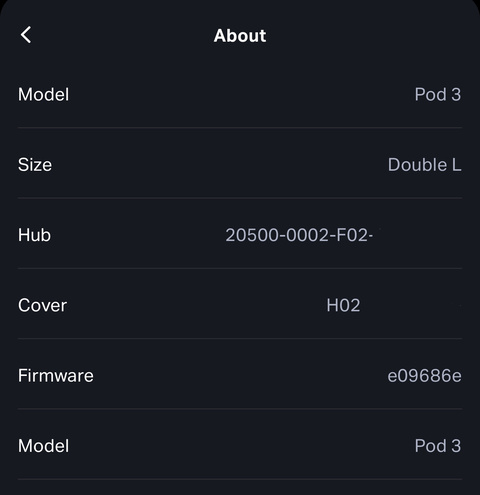Warning: This code is very new and immature. It works for me but requires technical know-how to use.
This repository contains a program intended to replace the dac process on an Eight Sleep Pod 3, giving the user the ability to interact with the pod locally, without any interaction with Eight Sleep's servers.
Clearly, this project is not endorsed by Eight Sleep. You're responsible for anything you do with your pod.
This has currently only been tested on a Pod 3 based on the Variscite VAR-SOM-MX8M-MINI.
Example board:
Example hardware info from Eight Sleep app:
To use:
- Power off your pod
- Remove the fan grille on the back of the Pod 3
- Unscrew the two screws at the top that hold on the top panel
- Pry the top plastic up, you'll reach a point where you can see clips holding the top panel to the side panels, stop here
- Remove the fabric mesh panel on the front of the device. There are two clips near the top that hook onto the plastic side panels. You can push these with a screwdriver.
- Unclip the clips near the top of the cylinder that holds the water supply and pull off the top panel. You should now have access to the logic board.
- There's a little daughterboard that looks like it's plugged into a RAM slot. Remove the screws from this board, and the antenna.
- Gently pull the board up, away from the thermal putty.
- Pull the board out.
- Remove the glue from the MicroSD slot that has been revealed
- Remove the MicroSD card from the slot
- Modify the rootfs.tar.gz file located at
/opt/images/Yocto/rootfs.tar.gzon the first partition of the MicroSD card.- Set the root password in
/etc/shadow - Add a
NetworkManagerconfiguration file at/etc/NetworkManager/system-connections/<something>.nmconnection - Add your SSH key to
/etc/ssh/authorized_keys(optionally, remove Eight Sleep's key while you're there)
- Set the root password in
- Insert the MicroSD card
- Insert the logic daughterboard
- Reattach the antenna
- Hold the smaller button on the back of the pod, next to the power cable. While the button is held in, plug the power in.
- After a few seconds, you should see the pod's light flash green. This indicates the device is performing a factory reset, using the
rootfs.tar.gzfile. - Eventually it'll stop flashing green and connect to wifi. You should now be able to ssh into your device using the account
rewt. You can also log in asrootby logging in asrewt, typingsuand entering the root password.
You can now compile this program for the Pod 3: cargo build --target aarch64-unknown-linux-musl (musl is used so that a static binary will work). Copy it to your Pod over ssh and you should be able to run it, although you'll need to run systemctl stop dac as root first to shut down the stock dac, which listens on the relevant unix socket.
You may want to disable Eight Sleep's updates and telemetry. You can do that with: systemctl disable --now swupdate-progress swupdate defibrillator eight-kernel telegraf vector. The frankenfirmware binary will still send data to raw-api-upload.8slp.net. If you want to deal with that, add raw-api-upload.8slp.net to your /etc/hosts file.
GET /hello: Checks whether the process can talk to the firmware. If it can, it will returnok, otherwise empty.GET /variables: Fetches current state of the Pod such as temperature.POST /alarm/<left/right>: Sets the alarm settings. The request body must be JSON of the following form:{"pl":50,"du":600,"tt":1700000000,"pi":"double"}plis the intensity of the vibrations as a percentage.duis presumed to be the maximum duration of the alarm in seconds.ttis the UNIX timestamp at which the alarm should be triggered.piis the vibration pattern.doubleis the old-style "strong" vibration,riseis the newer gentler pattern.
POST /alarm-clear: Clears the alarm. Unclear if any request body is necessary.POST /settings: Updates general settings. Request must be a JSON map. Onlylbis known, which is the percentage intensity of the pod's LED.POST /temperature/<left/right>: Sets the target temperature for the given side of the bed. Units are believed to be tenths of a degree, so 40 would be 4°C. Request body should be an integer encoded as plaintext. The unit will not switch on until a duration is also set.POST /temperature-duration/<left/right>: Sets the number of seconds until the pod should shut off. Stock Eight Sleep logic is to periodically set this to 7200 and switch it off manually by changing it to 0 when the pod should switch off.POST /prime: Presumably primes the pod. Takes a plaintext boolean (trueorfalse) as the request body. It's unclear what this means.
The API can easily be integrated with Home Assistant using the rest_command integration:
rest_command:
set_alarm:
url: http://<pod_ip>:8000/alarm/right
method: post
payload: '{"pl":{{strength}},"du":{{duration}},"tt":{{timestamp}},"pi":"{{pattern}}"}'
set_temp:
url: http://<pod_ip>:8000/temperature/right
method: post
payload: '{{temperature}}'
set_temp_duration:
url: http://<pod_ip>:8000/temperature-duration/right
method: post
payload: '{{duration}}'The relevant settings can be passed as data. Here's an example automation that sets the temperature based on a calendar where the event name is the desired temperature:
alias: Bed Calendar-driven Temperature
description: ""
trigger:
- platform: calendar
event: start
offset: "0:0:0"
entity_id: calendar.sleep
condition:
- condition: template
value_template: "{{trigger.calendar_event.summary | is_number}}"
action:
- repeat:
sequence:
- service: rest_command.set_temp
data:
temperature: "{{trigger.calendar_event.summary}}"
- service: rest_command.set_temp_duration
data:
duration: 7200
- delay:
hours: 0
minutes: 30
seconds: 0
milliseconds: 0
while:
- condition: template
value_template: "{{as_timestamp(trigger.calendar_event.end) > as_timestamp(now())}}"
mode: single
